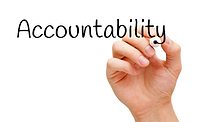Restoring Success: Assignment of Responsibility

“Who left that job site in that condition?”
Who was responsible for the job site that day?
“Who didn’t get the oil changed in the truck?”
Who is responsible for that and do they know they are responsible for it?
“Why can’t we get the warehouse reorganized?”
There is a highly engaged group who want to help but nobody is responsible to lead the group and the ultimate outcome.
If you ever have a situation like this and find yourself:
- Without an answer,
- An unclear answer, or
- Find the person that you held accountable was unclear about their responsibility...
...Then, it may be helpful to consider or review the of assignment of responsibility in your organization.
In the Year of Accountability, we look at the need and benefits of holding people accountable. Consider it difficult and demoralizing to hold someone accountable for something they have no responsibility for or understanding of their responsibility. If you are a person who is accountable for a project or task, something goes wrong, and you can’t identify who was responsible, the best way to avoid the problem again may lie within the assignment of responsibility.
There is a business saying that “things that get rewarded get done”. I will add to the notion that good people get things done well when they know that they are responsible for them. We can celebrate achievements and jobs well done and likewise develop people when responsibility is clear.
According to an article by Tracy Skousen, “80% of those surveyed say feedback is something that happens to them only when things go wrong or not at all.” Responsibility vs. Accountability; therefore, it is an important reminder to recognize the positive.
In the world of restoration, there are lots of moving parts: jobs, emergencies, estimating, hiring, training, vehicles, equipment, accounting, and so on. We have complex organizations and challenges inherent to our industry like managing catastrophic and/or high-volume response. In addition, in spite of procedures, standards, and best practices, our jobs are all unique for a variety of reasons.
The following are simplistic examples to consider. The principal applies to all team members at all levels and in all departments; it applies to projects and tasks.
Work Order or whatever the mechanism used to pass along instructions for field work.
- Day One: It starts out that one person with a team is in charge of the execution of the work order. The work order clearly states the “Joe” is responsible.
- End of Day One: The work is not completed that day and the original responsible person is not available to remain responsible the following day.
- Day Two: The same work order gets passed along to a new team. Joe had a scheduled day off and is no longer feeling the responsibility for the completion of the work order. He turned it in and said, “we didn’t get it done and …”
- Day Three: You are made aware of issues. You are accountable to your organization and proceed to figure out who is responsible for the issues.
-
You spin in circles:
- Joe was only responsible day one.
- There were people on day two but nobody was assigned the ultimate responsibility; they were handed Joe’s original work order with some notes.
- Some things were not done and you are going in circles trying to figure out if it was Joe missing something or the team didn’t follow something.
- Solution: Joe understands his responsibility is to clearly record what his team completed and did not complete on the original work order. He communicates this and a new work order with instructions/expectations is generated for day two and a person is assigned the responsibility of the execution.
Work Order II
- A technician who has been with the company for six months is sent to clean the carpet in the living room via work order.
- The following day you get a call that there was saw dust left on the kitchen floor and muddy foot prints.
- The carpet technician was the last one there and gets scolded for not noticing the saw dust and foot prints on the floor.
- Outcome: The technician may develop in his organizational awareness, he may grow and as he engages develop a sense of accountability for the overall operation of the company but at this point he did not know he should check other areas of the home. He followed his order and completed the carpet clean in the living room. He is held accountable for something he did not understand to be his responsibility. We may have demoralized a promising new technician who otherwise is performing well.
We are assigned responsibilities in our organizations in a variety of different ways: processes, procedures, job descriptions, best practices and by specific assignment on any given day. Things that get assigned to good people get done.
Looking for a reprint of this article?
From high-res PDFs to custom plaques, order your copy today!








